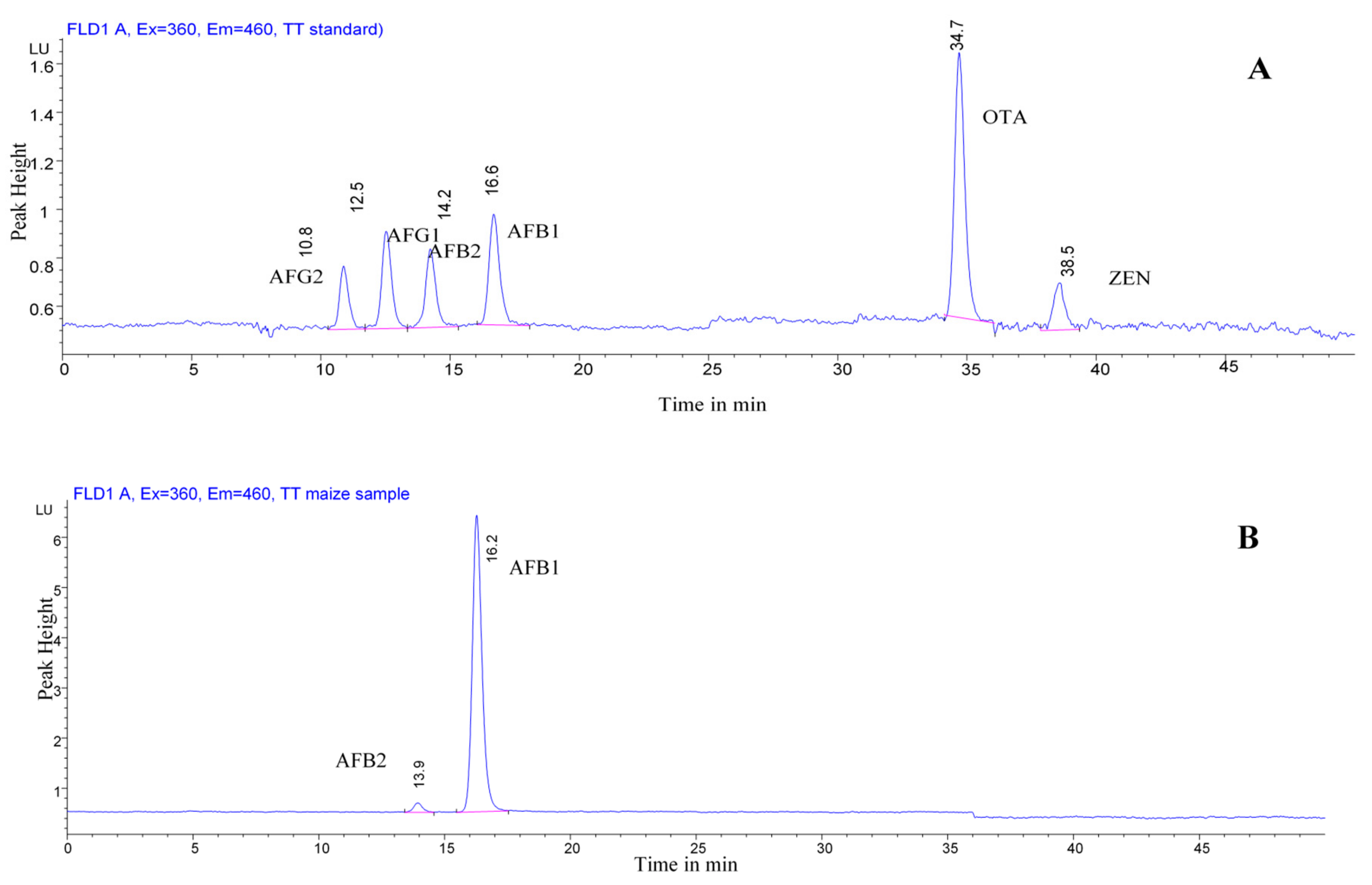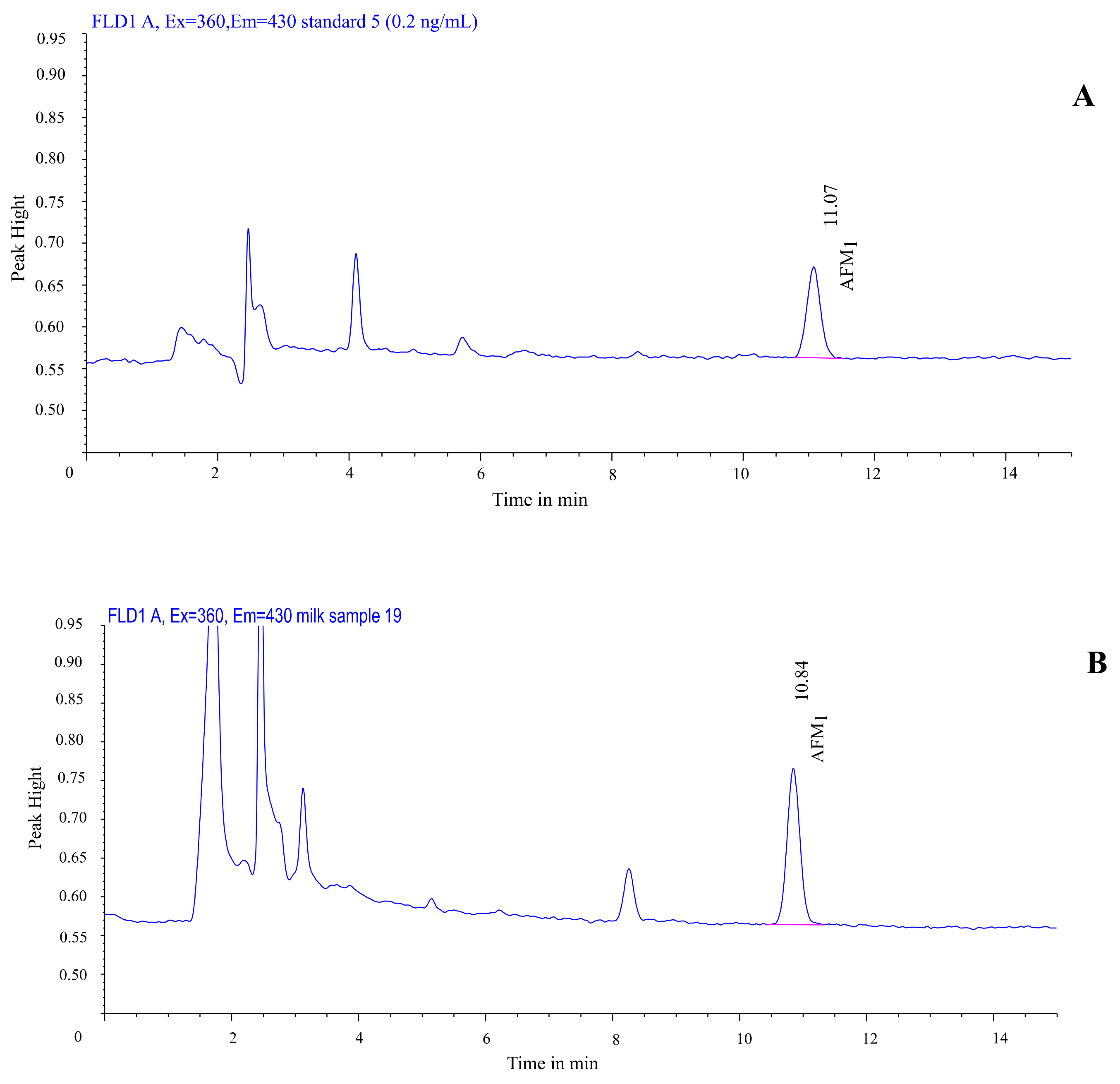Mycotoxin Detection in Maize, Commercial Feed, and Raw Dairy Milk Samples from Assiut City, Egypt
Abstract
1. Introduction
2. Materials and Methods
2.1. Sample Collection
2.2. Sample Preparation and Extraction
2.2.1. Maize and Animal Feed Samples
2.2.2. Dairy Milk Samples Extraction
2.2.3. HPLC Parameters for Multi-Mycotoxin and AFM1
3. Results and Discussion
3.1. Occurrence of Mycotoxins in Maize and Animal Feed Samples
3.2. Occurrence of AFM1 in Dairy Raw Samples
4. Conclusions
Author Contributions
Funding
Acknowledgments
Conflicts of Interest
References
- Hussein, H.S.; Brasel, J.M. Toxicity, metabolism, and impact of mycotoxins on humans and animals. Toxicology 2001, 167, 101–134. [Google Scholar] [CrossRef]
- Kovač, M.; Šubarić, D.; Bulaić, M.; Kovač, T.; Šarkanj, B. Yesterday masked, today modified; what do mycotoxins bring next? Arch. Ind. Hyg. Toxicol. 2018, 69, 196–214. [Google Scholar] [CrossRef] [PubMed]
- Marin, S.; Ramos, A.J.; Cano-Sancho, G.; Sanchis, V. Mycotoxins: Occurrence, toxicology, and exposure assessment. Food Chem. Toxicol. 2013, 60, 218–237. [Google Scholar] [CrossRef] [PubMed]
- Zain, M.E. Impact of mycotoxins on humans and animals. J. Saudi Chem. Soc. 2011, 15, 129–144. [Google Scholar] [CrossRef]
- Da Rocha, M.E.; Freire, F.D.; Maia, F.E.; Guedes, M.I.; Rondina, D. Mycotoxins and their effects on human and animal health. Food Control 2014, 36, 159–165. [Google Scholar] [CrossRef]
- Van Egmond, H.P.; Schothorst, R.C.; Jonker, M.A. Regulations relating to mycotoxins in food. Anal. Bioanal. Chem. 2007, 389, 147–157. [Google Scholar] [CrossRef] [PubMed]
- Food and Agriculture Organization (FAO) of the United Nations Worldwide regulations for mycotoxins in food and feed in 2003. FAO Food Nutr. Pap. 2004, 81, 9–28.
- Rahmani, A.; Jinap, S.; Soleimany, F. Validation of the procedure for the simultaneous determination of aflatoxins ochratoxin a and zearalenone in cereals using HPLC-FLD. Food Addit. Contam. Part A 2010, 27, 1683–1693. [Google Scholar] [CrossRef] [PubMed]
- Ofitserova, M.; Nerkar, S.; Pickering, M.; Torma, L.; Thiex, N. Multiresidue mycotoxin analysis in corn grain by column high-performance liquid chromatography with postcolumn photochemical and chemical derivatization: Single-laboratory validation. J. AOAC Int. 2009, 92, 15–25. [Google Scholar]
- El-Tahan, F.H.; El-Tahan, M.H.; Shebl, M.A. Occurrence of aflatoxins in cereal grains from four Egyptian governorates. Nahrung Food 2000, 44, 279–280. [Google Scholar] [CrossRef]
- El-Gohary, A.H. Study on aflatoxins in some foodstuffs with special reference to public health hazard in Egypt. Asian Australas. J. Anim. Sci. 1995, 8, 571–575. [Google Scholar] [CrossRef]
- Abd Alla, E.S. Zearalenone: Incidence, toxigenic fungi and chemical decontamination in Egyptian cereals. Nahrung Food 1997, 41, 362–365. [Google Scholar] [CrossRef] [PubMed]
- Salem, D.A. Natural Occurance of Aflatoxins in Feedstuffs and Milk of Dairy Farms in Assiut Porvince, Egypt. Wien. Tierarztl. Mon. 2002, 89, 86–91. [Google Scholar]
- Salem, D.A.; Ramadan, B.R. Occurrence of fumonisins in corn, wheat and some of their based-food products in Egypt. Assiut Med. J. 2009, 33, 147–158. [Google Scholar]
- Göbel, R.; Lusky, K. Simultaneous determination of aflatoxins, ochratoxin A, and zearalenone in grains by new immunoaffinity column/liquid chromatography. J. AOAC Int. 2004, 87, 411–416. [Google Scholar] [PubMed]
- Dragacci, S.; Grosso, F.; Gilbert, J. Immunoaffinity column cleanup with liquid chromatography for determination of aflatoxin M1 in liquid milk: Collaborative study. J. AOAC Int. 2001, 84, 437–443. [Google Scholar] [PubMed]
- Abdallah, M.F.; Girgin, G.; Baydar, T.; Krska, R.; Sulyok, M. Occurrence of multiple mycotoxins and other fungal metabolites in animal feed and maize samples from Egypt using LC-MS/MS. J. Sci. Food Agric. 2017, 97, 4419–4428. [Google Scholar] [CrossRef]
- Abia, W.A.; Warth, B.; Ezekiel, C.N.; Sarkanj, B.; Turner, P.C.; Marko, D.; Krska, R.; Sulyok, M. Uncommon toxic microbial metabolite patterns in traditionally home-processed maize dish (fufu) consumed in rural Cameroon. Food Chem. Toxicol. 2017, 107, 10–19. [Google Scholar] [CrossRef]
- Abdallah, M.F.; Krska, R.; Sulyok, M. Occurrence of ochratoxins, fumonisin B2, Aflatoxins (B1 and B2), and other secondary fungal metabolites in dried date palm fruits from Egypt: A mini-survey. J. Food Sci. 2018, 83, 559–564. [Google Scholar] [CrossRef]
- Abdallah, M.F.; Krska, R.; Sulyok, M. Mycotoxin contamination in sugarcane grass and juice: First report on detection of multiple mycotoxins and exposure assessment for aflatoxins B1 and G1 in Humans. Toxins 2016, 8, 343. [Google Scholar] [CrossRef]
- Binder, E.M.; Tan, L.M.; Chin, L.J.; Handl, J.; Richard, J. Worldwide occurrence of mycotoxins in commodities, feeds and feed ingredients. Anim. Feed Sci. Technol. 2007, 137, 265–282. [Google Scholar] [CrossRef]
- Petrić, J.; Šarkanj, B.; Mujić, I.; Mujić, A.; Sulyok, M.; Krska, R.; Šubarić, D.; Jokić, S. Effect of pretreatments on mycotoxin profiles and levels in dried figs. Arch. Ind. Hyg. Toxicol. 2018, 69, 328–333. [Google Scholar] [CrossRef] [PubMed]
- Kovač, T.; Šarkanj, B.; Crevar, B.; Kovač, M.; Lončarić, A.; Strelec, I.; Ezekiel, C.N.; Sulyok, M.; Krska, R. Aspergillus flavus NRRL 3251 growth, oxidative status, and aflatoxins production ability in vitro under different illumination regimes. Toxins 2018, 10, 528. [Google Scholar] [CrossRef] [PubMed]
- IARC. Some Traditional Herbal Medicines, Some Mycotoxins, Naphthalene and Styrene. Monogr. Eval. Carcinog. Risks Hum. 2002, 82, 301–366. [Google Scholar]
- Madbouly, A.K.; Ibrahim, M.I.M.; Sehab, A.F.; Abdel-Wahhab, M.A. Co-occurrence of mycoflora, aflatoxins and fumonisins in maize and rice seeds from markets of different districts in Cairo, Egypt. Food Addit. Contam. Part B 2012, 5, 112–120. [Google Scholar] [CrossRef] [PubMed]
- Nooh, A.; Hassan, A.; Youssef, M.M.; El-banna, A.A. Mycotoxin and toxigenic fungi occurrence in egyptian maize. Int. J. Adv. Res. 2014, 2, 521–531. [Google Scholar]
- Abdelhamid, A.M. Occurrence of some mycotoxins (aflatoxin, ochratoxin A, citrinin, zearalenone and vomitoxin) in various Egyptian feeds. Arch. Anim. Nutr. 1990, 40, 647–664. [Google Scholar] [CrossRef]
- Abdallah, M.F.; Girgin, G.; Baydar, T. Occurrence, prevention and limitation of mycotoxins in feeds. Anim. Nutr. Feed Technol. 2015, 15, 471–490. [Google Scholar] [CrossRef]
- El-Desouky, T.A.; Naguib, K. Occurrence of zearalenone contamination in some cereals in Egypt. J. Agroaliment. Process. Technol. 2013, 19, 445–450. [Google Scholar]
- Ghareeb, K.; Elmalt, L.M.; Awad, W.A.; Böhm, J.; Health, V.P.; Medicine, V.; Medicine, F.; Animals, F. Prevalence of Aflatoxin M 1 in Raw Milk Produced in Tropical State (Qena, Egypt) and Imported Milk Powder Sampling of milk. J. Vet. Anim. Sci. 2013, 3, 1–4. [Google Scholar]
- Alla, A.E.; Neamat-Allah, A.A.; Aly, S.E. Situation of mycotoxins in milk, dairy products and human milk in Egypt. Mycotoxin Res. 2000, 16, 91–100. [Google Scholar] [CrossRef] [PubMed]
- Motawee, M.M.; Bauer, J.; McMahon, D.J. Survey of Aflatoxin M1in Cow, Goat, Buffalo and Camel Milks in Ismailia-Egypt. Bull. Environ. Contam. Toxicol. 2009, 83, 766–769. [Google Scholar] [CrossRef] [PubMed]
- Shaker, E.; Elsharkawy, E. Occurrence and the level of contamination of aflatoxin M1in raw, pasteurized, and UHT buffalo milk consumed in Sohag and Assiut, Upper Egypt. J. Environ. Occup. Sci. 2014, 3, 136–140. [Google Scholar] [CrossRef]


| Mycotoxin | N (P) | Range (Min–Max) | Median | Mean | Recovery (%) |
|---|---|---|---|---|---|
| AFB1 | 8 (47%) | (0.1–5.9) | 0.7 | 1.5 | 110 |
| AFB2 | 1 (6%) | (0.5) | 0.5 | 0.5 | 81 |
| AFG1 | n.d | n.d | n.d | n.d | 79 |
| AFG2 | n.d | n.d | n.d | n.d | 80 |
| OTA | n.d | n.d | n.d | n.d | 95 |
| ZEA | 4 (24%) | (1.0–11.9) | 8.4 | 8.1 | 88.8 |
| Mycotoxin | N (P) | Range (Min–Max) | Median | Mean | Recovery (%) |
|---|---|---|---|---|---|
| AFB1 | 15 (25%) | (0.2–44.9) | 1.35 | 8.7 | 100 |
| AFB2 | 6 (10%) | (0.1–7.0) | 1.7 | 2.2 | 81 |
| AFG1 | n.d | n.d | n.d | n.d | 84 |
| AFG2 | n.d | n.d | n.d | n.d | 80.5 |
| OTA | n.d | n.d | n.d | n.d | 100 |
| ZEA | n.d | n.d | n.d | n.d | 85 |
© 2019 by the authors. Licensee MDPI, Basel, Switzerland. This article is an open access article distributed under the terms and conditions of the Creative Commons Attribution (CC BY) license (http://creativecommons.org/licenses/by/4.0/).
Share and Cite
F. Abdallah, M.; Girgin, G.; Baydar, T. Mycotoxin Detection in Maize, Commercial Feed, and Raw Dairy Milk Samples from Assiut City, Egypt. Vet. Sci. 2019, 6, 57. https://doi.org/10.3390/vetsci6020057
F. Abdallah M, Girgin G, Baydar T. Mycotoxin Detection in Maize, Commercial Feed, and Raw Dairy Milk Samples from Assiut City, Egypt. Veterinary Sciences. 2019; 6(2):57. https://doi.org/10.3390/vetsci6020057
Chicago/Turabian StyleF. Abdallah, Mohamed, Gözde Girgin, and Terken Baydar. 2019. "Mycotoxin Detection in Maize, Commercial Feed, and Raw Dairy Milk Samples from Assiut City, Egypt" Veterinary Sciences 6, no. 2: 57. https://doi.org/10.3390/vetsci6020057
APA StyleF. Abdallah, M., Girgin, G., & Baydar, T. (2019). Mycotoxin Detection in Maize, Commercial Feed, and Raw Dairy Milk Samples from Assiut City, Egypt. Veterinary Sciences, 6(2), 57. https://doi.org/10.3390/vetsci6020057






